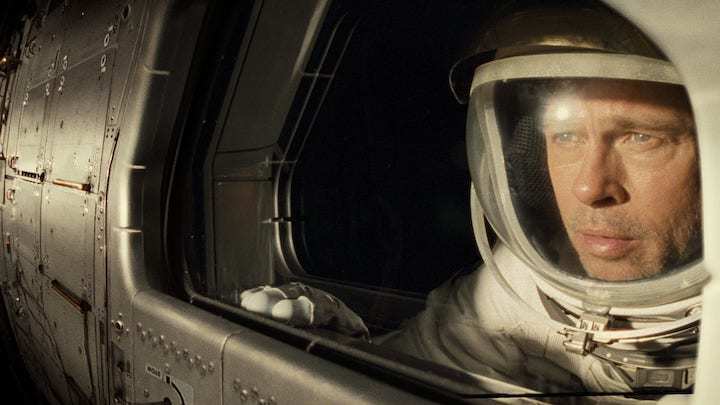22.09.2019
One of America’s biggest tech firms paid Disney to have its spacecraft designs and logo featured heavily throughout the Brad Pitt-starring space epic. Here’s why.

ased on the early reviews, writer-director James Gray’s new space epic Ad Astra is at once meditative and exciting, with sweeping visuals, visceral action and a brooding performance by star Brad Pitt.
The $80 million movie, which opens Friday, also is a public relations coup for one of America’s biggest technology firms. Maryland-based Lockheed Martin not only consulted on the design of the film’s spacecraft, space stations, moon landers and other tech—it also paid Disney, the studio behind Ad Astra, to slap its logo on the movie’s costumes and props.
Lockheed, builder of the F-22 and F-35 stealth fighters, the Orion space capsule and other high technology, is a big part of Gray’s fictional world. Hollywood and America’s space sector for decades have enjoyed a symbiotic relationship. Arguably, they’ve never been closer than they are in Ad Astra.
In Gray’s film, Pitt plays a U.S. military space operator on a lonely and dangerous mission to find his long-lost astronaut father, portrayed by Tommy Lee Jones. Pitt’s character must travel to the moon then onward to Mars in order to activate a laser communication system that can reach Neptune.
Things get complicated. It seems space pirates are involved.
Pitt’s company Plan B, which produced Ad Astra alongside New Regency and 20th Century Fox (before Disney completed its acquisition of Fox in early 2019) approached Lockheed back in 2017, when the movie was still in pre-production.
Gray wanted his near-future story to feel grounded in our own present. He asked to tap Lockheed’s expertise as a builder of rockets and spacecraft. “They came to us not necessarily looking for brand involvement… but first and foremost for advisement,” Mark Lewis, Lockheed’s liaison to the production, told The Daily Beast.
The idea was for the technology in the movie to seem just slightly more advanced than our own is, and for it to fit into the everyday life of the movie’s world in a way that feels realistic. Lockheed helped Plan B design capsules, landers and spacesuits and communication arrays.
The plane-maker brought in former astronauts Steve Frick and Tony Antonelli, both now Lockheed employees, to advise Pitt and the other actors on the grittier aspects of living and working in space, down to “how astronauts would smell being trapped in a capsule for years on end," Lewis said.
“It lends a feeling of authenticity and focus on detail that you cannot reproduce,” Gray said of Lockheed’s involvement in the film. “You want to convey a world that people can connect to, that seems like the one that we live in today.”
Lockheed offered its advice for free, as did NASA, which also gave the production stock footage and photographs. Both Lockheed and NASA said they viewed their initial involvement as an investment in America’s future technology workforce. “Films are a really important way to reach people,” Bert Ulrich, NASA’s liaison to Hollywood, told The Daily Beast.
For Lockheed there also was an opportunity to portray itself on film. For a fee.
Gray aimed to populate his space opera with real companies. Major brands lined up to get their logos and products on screen. There’s a DHL booth near an Applebee’s at the movie’s spaceport. Real-life space-tourism firm Virgin Galactic runs a shuttle service to Ad Astra’s moon base.
Lockheed ponied up an undisclosed sum to be the film’s main builder of high technology. Virgin Galactic operates Ad Astra’s shuttle, but the fictionalized version of Lockheed actually builds it. You’ll see workers in Lockheed jumpsuits tending to the craft. “I bet this is the first and only time that Lockheed Martin will be partnered with Applebee’s in a sentence,” Gray joked in a Lockheed promotional video.
“This is a different way we can present Lockheed Martin as that visionary, as a builder of the future,” Lewis said. “What better way to do that than in major motion picture?”
The downside, of course, is that the movie could flop. “That’s definitely a risk we took,” Lewis said. Some of the space industry insiders The Daily Beast spoke with still are stinging from their involvement with Gravity, the 2013 Sandra Bullock-starring space-survival film that won praise for its performances, but whose portrayal of technology and orbital physics is, to put it gently, lacking in realism.
But industry and government have been gambling on flying and space movies for decades, and mostly winning. The very first Oscar-winner, in 1927, was the aviation drama Wings. Eccentric industrialist Howard Hughes, who died in 1976, made movies and airplanes with equal abandonand found any excuse to include the latter in the former.
The Right Stuff in 1983 and Apollo 13 in 1995 raised the bar for audiences, filmmakers and industry executives. More and more, the makers of real technology want to be a part of made-up stories in order to inspire real investors, voters and future tech workers. “A lot of science institutions have gotten more savvy about outreach,” Peter Westwick, a space historian at the University of Southern California, told The Daily Beast.
It remains to be seen whether Ad Astra will do for the space industry what The Right Stuff and Apollo 13 did. The early reviews are glowing. But then, critics loved 2018’s Neil Armstrong-biopic First Man, too—and that flick flopped at the box office.
NASA film-liaison Ulrich caught an advance screening of Ad Astra but agreed not to comment on the movie besides calling it “inspirational.”
Lockheed’s Lewis also was coy. “Any space movie that captures emotions and interests in people is a good thing for us.”
Quelle: Daily Beast
